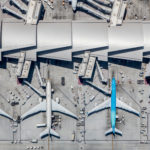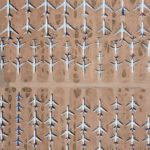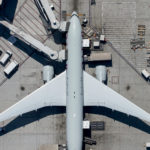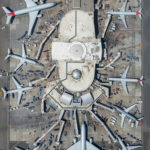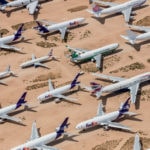
A photo series that lends a view to an aircraft’s life cycle from above.
Mike Kelley is a Los Angeles-based architectural photographer who has been into aviation as far back as he can remember. As a 10-year-old, he would go with his dad to watch airplanes take off and land at Boston Logan International Airport. As he got older, instead of going to the mall, he would hang out at the airport to pass the time.
In 2014, Kelley did an aerial photo assignment for a property developer in LA. He needed to charter a helicopter to get those aerial shots, and the flight path to the location cut directly above LAX and the center of its four runways. Amazed that helicopters were allowed to fly between the runways, he asked himself, “How is this even legal?”
Kelley kept in touch with that helicopter pilot and hired him for future assignments. As the two became friends, Kelley inquired about the legality of hovering directly above the airport. “It turns out it’s not really an issue at all,” Kelley says. “If there’s one airport in the world to do it at, LAX is kind of the one.” One month later, LAX’s air traffic controllers gave Kelley the all-clear to loiter above the airport and take pictures of the aircraft directly below.
“When you’re looking through the camera, you don’t feel as if you’re doing what you’re doing. It does not feel as insane as it sounds,” – Mike Kelley
To get the shots, Kelley engaged in what he describes as “high-stakes planespotting,” which involved attaching himself to a five-point harness tethered to a crossbar on the helicopter. The pilot would then bank the helicopter at a 45-degree angle where Kelley was able to take shots directly below with his Canon 5DS R. “I wasn’t dangling out in the sky, but there was nothing underneath me when we were doing this,” he explains.
“When you’re looking through the camera, you don’t feel as if you’re doing what you’re doing. It does not feel as insane as it sounds. But then you look back at the photo and think, How did I take that picture? While you are up there you don’t think about the fact that there’s 2,000 feet between you and the ground.”
Back on firmer ground, Kelley says he was shocked at how cool the images were and wanted to release them, but was concerned that they didn’t have an interesting story behind them: “Guy rents helicopter and gets great pictures – it’s not that interesting. How do I make this something a bit more than just that?” Kelley came up with the idea of heading to the Victorville boneyard located in the Mojave Desert to photograph hundreds of aircraft at the end of their lives, all lined up, gutted and recycled for their aluminum.

The final element emerged during some free time while on a work trip to Seattle. Kelley realized he might have the opportunity to photograph Boeing aircraft rolling off the assembly line. He frantically called a helicopter operator in Seattle and extended his trip by a few days to get the same kind of aerial shots he had taken at LAX and Victorville.
“It’s a story of the three different phases of aircraft – of their life cycle,” – Mike Kelley
“So now I’ve got these planes being assembled in Seattle, I’ve got them at LAX and I’ve got them at the boneyard. I thought, Alright, I have a story here,” Kelley recalls. “It’s a story of the three different phases of aircraft – of their life cycle. Each of them is equally interesting in this sort of artistic graphic way when photographed from above.”
“Time Lapse” was originally published in the 9.3 June/July issue of APEX Experience magazine



